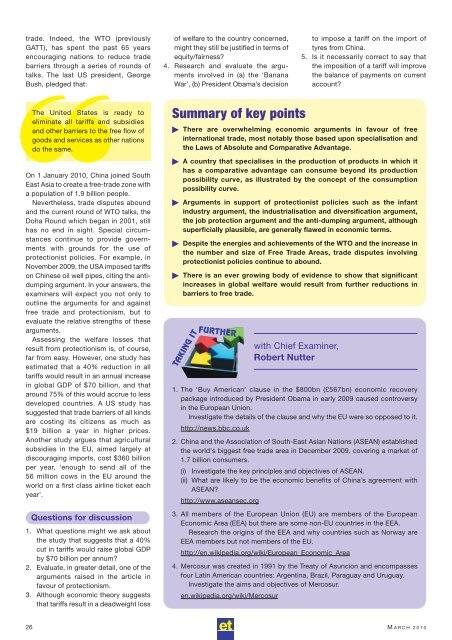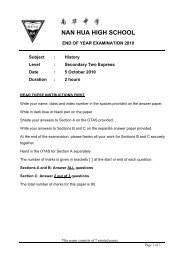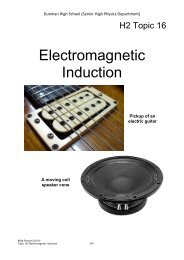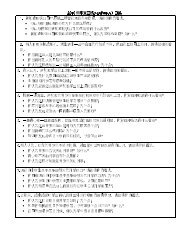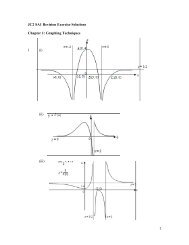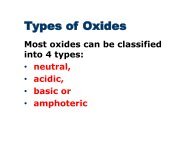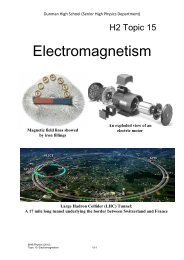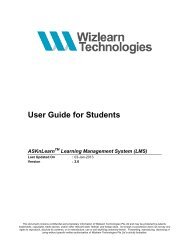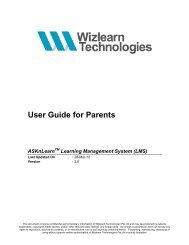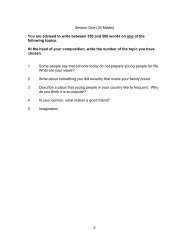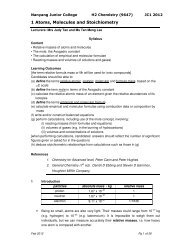Eco Today - Mar10:ET Master Page 2007 - ASKnLearn
Eco Today - Mar10:ET Master Page 2007 - ASKnLearn
Eco Today - Mar10:ET Master Page 2007 - ASKnLearn
You also want an ePaper? Increase the reach of your titles
YUMPU automatically turns print PDFs into web optimized ePapers that Google loves.
trade. Indeed, the WTO (previously<br />
GATT), has spent the past 65 years<br />
encouraging nations to reduce trade<br />
barriers through a series of rounds of<br />
talks. The last US president, George<br />
Bush, pledged that:<br />
of welfare to the country concerned,<br />
might they still be justified in terms of<br />
equity/fairness?<br />
4. Research and evaluate the argu -<br />
ments involved in (a) the ‘Banana<br />
War’, (b) President Obama’s decision<br />
to impose a tariff on the import of<br />
tyres from China.<br />
5. Is it necessarily correct to say that<br />
the imposition of a tariff will improve<br />
the balance of payments on current<br />
account?<br />
❝The United States is ready to<br />
eliminate all tariffs and subsidies<br />
and other barriers to the free flow of<br />
goods and services as other nations<br />
do the same.<br />
On 1 January 2010, China joined South<br />
East Asia to create a free-trade zone with<br />
a population of 1.9 billion people.<br />
Nevertheless, trade disputes abound<br />
and the current round of WTO talks, the<br />
Doha Round which began in 2001, still<br />
has no end in sight. Special circum -<br />
stances continue to provide govern -<br />
ments with grounds for the use of<br />
protectionist policies. For example, in<br />
November 2009, the USA imposed tariffs<br />
on Chinese oil well pipes, citing the antidumping<br />
argument. In your answers, the<br />
examiners will expect you not only to<br />
outline the arguments for and against<br />
free trade and protectionism, but to<br />
evaluate the relative strengths of these<br />
arguments.<br />
Assessing the welfare losses that<br />
result from protectionism is, of course,<br />
far from easy. However, one study has<br />
estimated that a 40% reduction in all<br />
tariffs would result in an annual increase<br />
in global GDP of $70 billion, and that<br />
around 75% of this would accrue to less<br />
developed countries. A US study has<br />
suggested that trade barriers of all kinds<br />
are costing its citizens as much as<br />
$19 billion a year in higher prices.<br />
Another study argues that agricultural<br />
subsidies in the EU, aimed largely at<br />
discouraging imports, cost $360 billion<br />
per year, ‘enough to send all of the<br />
56 million cows in the EU around the<br />
world on a first class airline ticket each<br />
year’.<br />
Questions for discussion<br />
1. What questions might we ask about<br />
the study that suggests that a 40%<br />
cut in tariffs would raise global GDP<br />
by $70 billion per annum?<br />
2. Evaluate, in greater detail, one of the<br />
arguments raised in the article in<br />
favour of protectionism.<br />
3. Although economic theory suggests<br />
that tariffs result in a deadweight loss<br />
Summary of key points<br />
There are overwhelming economic arguments in favour of free<br />
international trade, most notably those based upon specialisation and<br />
the Laws of Absolute and Comparative Advantage.<br />
A country that specialises in the production of products in which it<br />
has a comparative advantage can consume beyond its production<br />
possibility curve, as illustrated by the concept of the consumption<br />
possibility curve.<br />
Arguments in support of protectionist policies such as the infant<br />
industry argument, the industrialisation and diversification argument,<br />
the job protection argument and the anti-dumping argument, although<br />
superficially plausible, are generally flawed in economic terms.<br />
Despite the energies and achievements of the WTO and the increase in<br />
the number and size of Free Trade Areas, trade disputes involving<br />
protectionist policies continue to abound.<br />
There is an ever growing body of evidence to show that significant<br />
increases in global welfare would result from further reductions in<br />
barriers to free trade.<br />
with Chief Examiner,<br />
Robert Nutter<br />
1. The ‘Buy American’ clause in the $800bn (£567bn) economic recovery<br />
package introduced by President Obama in early 2009 caused controversy<br />
in the European Union.<br />
Investigate the details of the clause and why the EU were so opposed to it.<br />
http://news.bbc.co.uk<br />
2. China and the Association of South-East Asian Nations (ASEAN) established<br />
the world's biggest free trade area in December 2009, covering a market of<br />
1.7 billion consumers.<br />
(i) Investigate the key principles and objectives of ASEAN.<br />
(ii) What are likely to be the economic benefits of China’s agreement with<br />
ASEAN?<br />
http://www.aseansec.org<br />
3. All members of the European Union (EU) are members of the European<br />
<strong>Eco</strong>nomic Area (EEA) but there are some non-EU countries in the EEA.<br />
Research the origins of the EEA and why countries such as Norway are<br />
EEA members but not members of the EU.<br />
http://en.wikipedia.org/wiki/European_<strong>Eco</strong>nomic_Area<br />
4. Mercosur was created in 1991 by the Treaty of Asuncion and encompasses<br />
four Latin American countries: Argentina, Brazil, Paraguay and Uruguay.<br />
Investigate the aims and objectives of Mercosur.<br />
en.wikipedia.org/wiki/Mercosur<br />
26 M ARCH 2010


